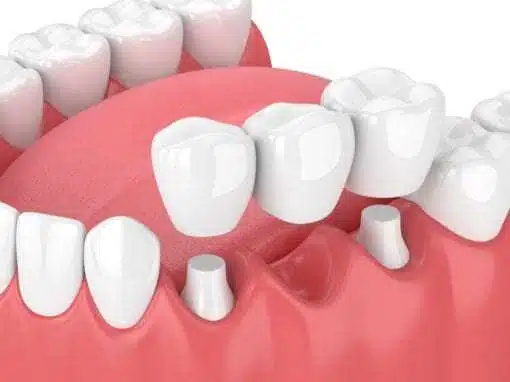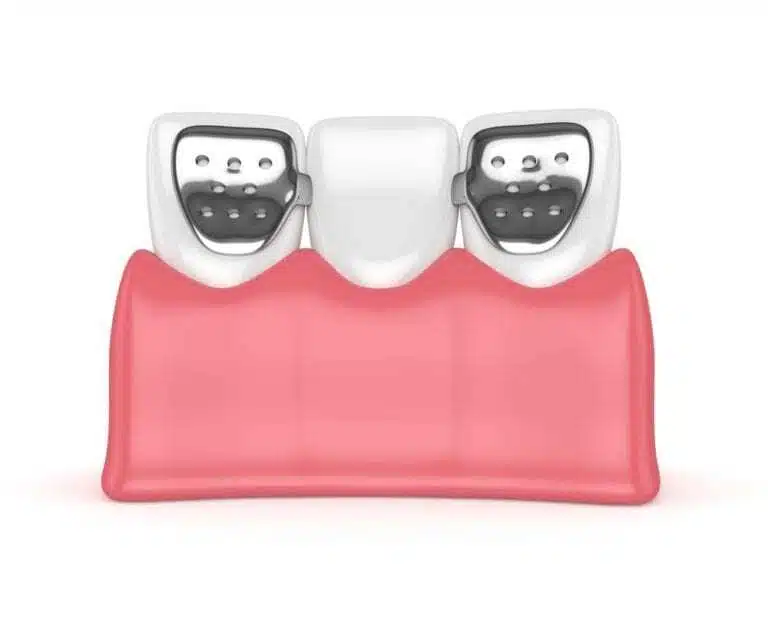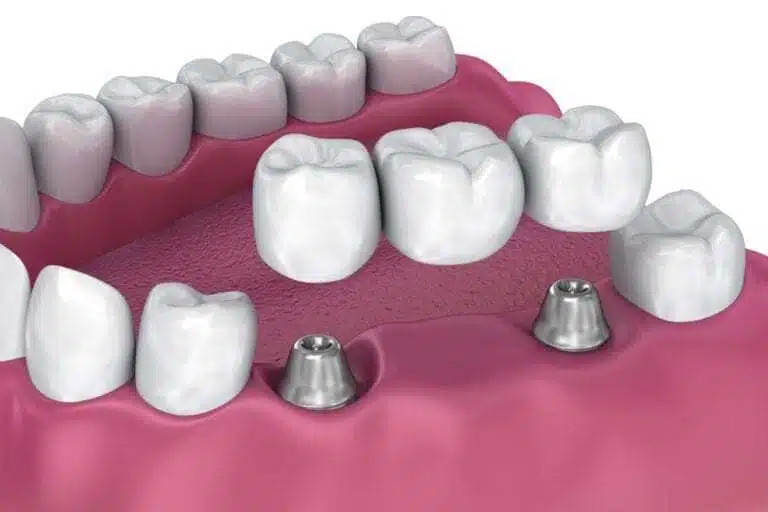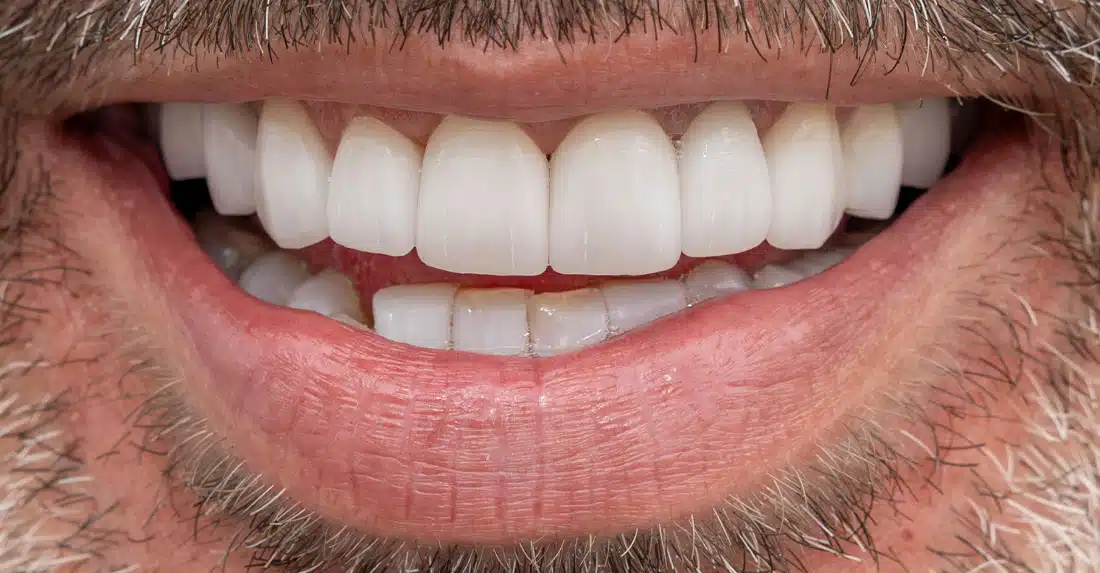Replace Missing Teeth With Dental Bridges
A dental bridge is a dental restoration that replaces one or more missing teeth by bridging the gap between two existing teeth.
The bridge comprises one or more artificial teeth (called pontics) anchored in place by dental crowns attached to the surrounding teeth.
Bridges can be made from various materials, including porcelain, ceramic, and metal alloys. The type of material used will depend on the bridge’s location, the patient’s aesthetic preferences, and other factors.
Benefits of Dental Bridges
Dental bridges can provide a long-lasting solution for replacing missing teeth and can help restore the mouth’s function and appearance.
With proper care, dental visits and at-home maintenance, a dental bridge can last 10-15 years or more and provide a durable and effective solution for restoring the smile.
Types of Dental Bridges
A traditional bridge is a dental prosthesis used to replace one or more missing teeth.
It consists of one or more artificial teeth, called pontics, anchored by dental crowns placed on the natural teeth on either side of the gap.
The procedure to place a traditional bridge usually requires two or more dental appointments.
During the first appointment, the dentist will prepare the abutment teeth, or the natural teeth on either side of the gap, by removing a small amount of tooth structure to allow room for the dental crowns.
Then, the dentist will take impressions of the prepared teeth, which will be used to create a custom bridge in a dental laboratory.
The dentist will place the bridge at the second appointment, ensuring it fits properly and feels comfortable. The bridge will be secured in place using a strong dental adhesive.
Traditional bridges have several advantages, including:
- Improved appearance: Bridges can improve the appearance of your smile by filling in gaps left by missing teeth.
- Restored functionality: Bridges can restore the ability to eat and speak normally, which can be compromised by missing teeth.
- Durability: A traditional bridge can last many years with proper care and maintenance.
However, traditional bridges also have some drawbacks.
They require the removal of healthy tooth structure on the abutment teeth, which can compromise their long-term health. They may also be more expensive than dental prostheses, such as removable dentures.
Your restorative dentist can help determine if a traditional bridge is the best option for your dental needs.
A cantilever bridge is a type of bridge that is supported by cantilevers, which are horizontal beams or structures that project out from a vertical support.
The cantilevers are anchored at one end and are free to move at the other end, allowing them to support the weight of the bridge deck and any traffic that crosses it.
The basic structure of a cantilever bridge consists of two cantilever arms, each extending from opposite sides of a central tower or pier.
These arms are often made of steel trusses, which are strong and lightweight, and are connected to each other and to the tower by additional steel girders or braces.
The deck of the bridge, which carries the roadway or pedestrian pathway, is then suspended from the cantilever arms by vertical hangers or cables.
One advantage of cantilever bridges is that they can span relatively long distances without requiring intermediate supports or piers, making them suitable for crossing large bodies of water or deep valleys.
They can also be designed to accommodate a wide range of traffic loads, from pedestrians and bicycles to heavy trucks and trains.
However, they do require careful engineering and maintenance to ensure their stability and safety over time.
There is a dental procedure called the Maryland bridge, also known as a resin-bonded bridge or a Maryland bonded bridge.
This type of dental bridge is a relatively conservative and cost-effective option for replacing missing teeth, particularly for front teeth that are visible when you smile.
The Maryland bridge consists of a prosthetic tooth, or pontic, that is held in place by a thin metal or ceramic framework.
This framework is bonded to the back of the adjacent teeth using a special dental adhesive, which eliminates the need for drilling or removing healthy tooth structure.
Maryland bridges have several advantages over traditional bridges, including:
- Minimal tooth reduction: Unlike traditional bridges, Maryland bridges do not require the removal of healthy tooth structure.
- Quick and easy to place: Maryland bridges can be placed in a single visit to the dentist.
- Cost-effective: Maryland bridges are generally less expensive than other types of dental bridges.
However, Maryland bridges are not suitable for all patients, and they may not be as durable or long-lasting as other types of bridges.
Your cosmetic dentist from Amazing Smiles can help you determine if a Maryland bridge is the right choice for your dental needs.
An implant-supported bridge is a dental bridge anchored to dental implants rather than natural teeth. Dental implants are titanium posts surgically placed into the jawbone to act as artificial tooth roots.
The bridge is then secured to the implants, providing a stable and permanent solution for multiple missing teeth.
There are several benefits to choosing an implant-supported bridge over other tooth replacement options. First, because the bridge is anchored to the implants, it does not rely on neighbouring teeth for support.
This means healthy teeth do not need to be altered or damaged to support the bridge, as with a traditional dental bridge.
The implants also stimulate the jawbone, which helps prevent bone loss that can occur when teeth are missing.
Another benefit of an implant-supported bridge is that it is a long-lasting solution that can provide a natural-looking and functioning replacement for missing teeth.
With proper care and maintenance, implant-supported bridges can last for many years, making them a cost-effective option in the long run.
They also provide improved stability and comfort compared to other tooth replacement options, such as dentures.
Overall, an implant-supported bridge is an excellent choice for individuals who are missing multiple teeth and are looking for a permanent and natural-looking solution.
Transforming Your Smile Begins Here
Post-op photos taken directly after treatment
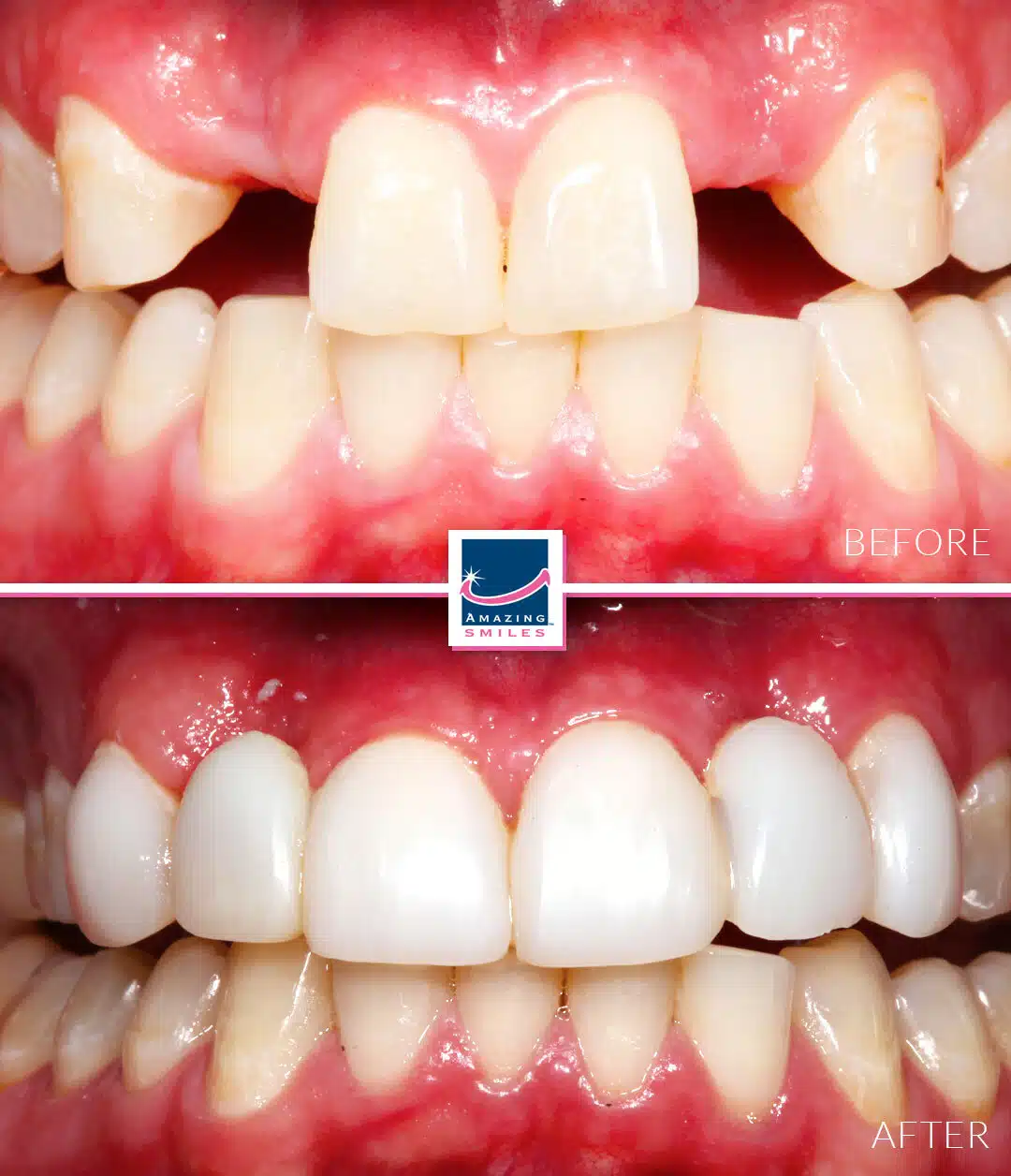
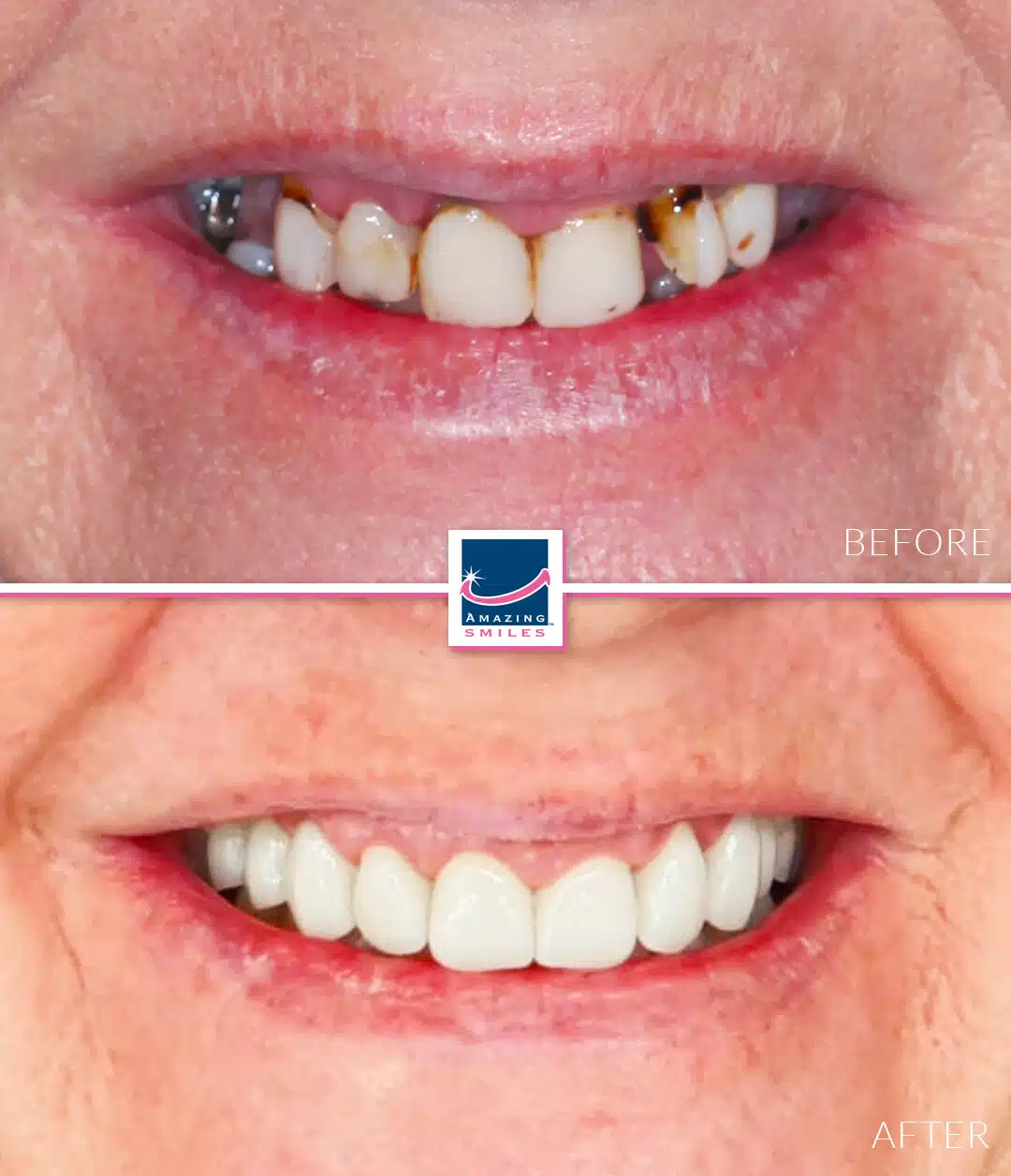


Improve your smile with missing tooth replacement
The process of getting a dental bridge

Dental Examination

Preparation, Impression, and Temporary Bridge

Fitting and Adjustment

Placement and Follow-Up
Amazing Smiles Restorative Dentists are committed to providing our patients with safe, effective, and long-lasting dental solutions. Our experienced dentists use the latest techniques and dental technologies to ensure you receive the best care. We are dedicated to ensuring your comfort and satisfaction throughout the dental bridge process. Trust us to restore your smile and improve oral health with a high-quality dental bridge.
The Benefits of Dental Bridges
This means they offer a more natural feel and look, as they do not move or slip like dentures can.
Additionally, dental bridges can restore the patient’s ability to chew and speak properly, improving their quality of life.
They can also help maintain the face’s shape, preventing a sunken-in appearance that can occur when teeth are missing.
Overall, dental bridges provide a reliable and effective solution for those missing one or more teeth and can greatly improve the overall oral health and well-being of patients.
Making a Dental Bridge
Fabrication of dental bridges is a multi-step process involving high precision and attention to detail.
Amazing Smiles dentists on the Gold Coast and Brisbane surrounding areas are meticulous, aiming for perfect results for every patient.
The cost of dental bridges is attributed to requiring technical skill and expertise. This process involves taking detailed impressions of the patient’s teeth and mouth to ensure a perfect fit.
The bridge is designed and fabricated in an Australian dental laboratory, where skilled technicians use advanced equipment, technologies and techniques to create a precise fit and natural appearance.
Once the bridge is completed, it is carefully placed by a skilled dentist and adjusted to ensure optimal functionality.
At Amazing Smiles, we use only the highest-quality materials to create dental bridges that look and feel like natural teeth, providing our patients with a beautiful and functional smile that they can be proud of for years.
Why Choose Us for Dental Bridges?
Our team of experienced cosmetic dentists use the latest technology and techniques to create customized dental bridges that look and feel natural.
We understand that missing teeth can significantly impact your confidence and daily life, which is why we work closely with our patients to ensure they are fully satisfied with their dental bridge.
With our patient-centric approach and commitment to excellence, you can trust that you are in good hands with Amazing Smiles.
Don’t let missing teeth hold you back any longer, schedule a consultation with us today and see the difference a dental bridge can make in your smile and quality of life.

The lifespan of dental bridges depends on several factors, such as the type of material used, the location of the bridge in the mouth, the oral hygiene practices of the patient, and any habits or behaviours that may cause damage to the bridge. On average, dental bridges can last between 10 to 15 years or even longer with proper care and maintenance.
To help ensure the longevity of dental bridges, it is important to practice good oral hygiene, including brushing and flossing regularly and visiting the dentist for regular check-ups and cleanings. It is also important to avoid habits that can damage the bridge, such as chewing on hard objects, using teeth as tools, or grinding or clenching the teeth.
Regular check-ups with a dentist are important to monitor the bridge’s health and detect any signs of damage or wear. If a dental bridge becomes loose or damaged, it is important to seek prompt dental care to prevent further damage and maintain the function and appearance of the bridge. Sometimes, a damaged bridge may need to be replaced with a new one.
The cost of a dental bridge in Australia can vary depending on several factors, including the materials used in the bridge, the complexity of the case, units (teeth) required, and if additional gum or tooth treatment is required during preparation. It is important to arrange an initial consultation with our cosmetic dental team to determine the specific cost of your dental bridge based on your individual needs and circumstances.
The type of dental bridge discussed between the patient and dentist will affect the overall cost. The type of dental bridge affecting cost will vary between:
- Traditional Bridge
- Cantilever Bridge
- Maryland Bridge
- Implant Bridge
Additionally, some dental insurance plans may cover a portion of the cost of a dental bridge, which can help offset the overall expense.
If your dental bridge breaks, seeing your dentist as soon as possible is important. Your Amazing Smiles Cosmetic Dentist can evaluate the extent of the damage and determine the best course of action. Sometimes, the bridge can be repaired or recemented back in place. In other cases, a new bridge may need to be made. It is important to take care of your dental bridge and avoid biting down on hard foods or objects to prevent damage. Regular dental checkups can also help catch any potential problems with your dental bridge early on.
A pontic is the fake artificial tooth of a fixed dental bridge or partial denture. Pontics are either made of ceramic or porcelain with metal.
Pontics are made as a single prosthetic and look similar to a natural tooth along the gum line.
Dental decay can occur beneath a dental bridge if proper oral hygiene practices are not followed. The area where the bridge meets the gum line is particularly vulnerable to decay as food particles and bacteria can accumulate there.
To make a dental bridge last longer, it’s important to maintain good oral hygiene practices, including brushing twice daily, flossing regularly, and using an antibacterial mouthwash. Regular dental check-ups and cleans are important for identifying and addressing issues early on. Avoiding hard and sticky foods that could damage the bridge can also help prolong its lifespan. Finally, addressing any grinding or clenching habits with a night guard can also help prevent excessive wear and tear on the bridge.
Patients can use their private health insurance to claim the cost of a dental bridge, but the amount of coverage will vary depending on the individual’s insurance plan. Dental bridges are typically classified as major dental procedures and may require a waiting period before insurance coverage can be used.
Patients need to contact their private health insurance provider to determine the exact level of coverage they can receive for a dental bridge. Some insurance plans may only cover a portion of the cost, leaving the patient responsible for the remainder. Patients should also inquire about limits on the number of bridges covered and any annual limits on benefits.
At Amazing Smiles, our compassionate team is dedicated to helping patients navigate the insurance process and ensuring they receive the maximum coverage possible. We understand that dental bridges can be a significant investment, and we work closely with our patients to create a personalized treatment plan that meets their needs and budget. Contact us today to schedule a consultation and learn more about our affordable dental bridge options.
Dental Bridge Item Numbers (treatments may differ based on patients’ needs):
- Prosthodontics – Provisional Crown and Bridge
- 631 Provisional crown
- 632 Provisional bridge – per pontic
- 633 Provisional implant abutment – per abutment
- 634 Provisional implant restoration – per implant
- Prosthodontics – Bridges
- 642 Bridge pontic – direct – per pontic
- 643 Bridge pontic – indirect – per pontic
- 649 Bonded retainer – indirect – per tooth
- Prosthodontics – Crown and Bridge Repairs and
Other Services- 651 Recementing crown or veneer
- 652 Recementing bridge or splint – per abutment
- 655 Removal of crown
There are several reasons why a patient may choose a dental bridge over a denture.
- First, a bridge is a more permanent solution as it is fixed in place and does not need to be removed for cleaning. This can be more convenient for patients without worrying about removing and cleaning a denture daily.
- Second, a bridge can provide stability and chewing power when anchored to the surrounding teeth or dental implants. Dentures may slip or shift during eating or speaking, whereas a bridge remains securely in place.
- Lastly, a dental bridge can have a more natural appearance and feel than a denture. It is custom-made to match the shape and colour of a patient’s natural teeth and can be indistinguishable from the surrounding teeth.
Ultimately, deciding to get a dental bridge or a denture depends on a patient’s needs and preferences. Our restorative dental team can help evaluate the patient’s situation and recommend the best treatment course.
Diet changes are generally not necessary with a dental bridge, but patients should still be mindful of the foods they eat to prevent damage to the bridge. Sticky or hard foods, such as caramel, candy, and ice, should be avoided, as they can dislodge or damage the bridge. Patients should also be cautious when eating foods that require a lot of chewing, such as tough meats or raw vegetables, as excessive force can damage the bridge or the natural teeth supporting it. A well-balanced diet with plenty of fruits and vegetables is important for maintaining good oral and overall health. Still, patients may need to cut their food into smaller pieces or avoid certain foods if they have difficulty chewing with the bridge in place. Overall, it is important to maintain good oral hygiene habits, such as brushing and flossing regularly, to prevent decay or damage to the bridge or natural teeth.
Dental bridges are made of materials that are typically stain-resistant, such as porcelain or zirconia, and are designed to match the colour of the surrounding teeth. However, over time, the bridge may appear to change colour due to wear and tear, staining from certain foods and drinks, or natural discolouration of the surrounding teeth. This can be remedied with regular dental cleanings and maintenance and avoiding foods and drinks known to stain teeth. Sometimes, the bridge may need to be replaced to restore its natural colour and appearance.
We accept all major health funds


